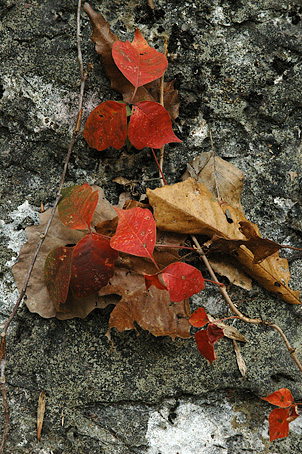|
Fall is a time when many trees are
fruiting, so look closely at the surface of the trail as you walk
along. Many fruits and seeds can be found along the trail this
way. Animals preparing for winter are busy gathering and
storing these fruits and seeds and you can often see them carrying
some choice morsel to a hiding spot.
From the trailhead the trail slopes
up gently towards station one. Note the bright colors of the Sugar
Maples on the left of the trail at the trailhead. On the right
is a stand of Eastern Hophornbeams. Look for the hop-like
catkins drooping from the branches of the Eastern Hophornbeams.
We will learn more about this species later on the trail.
Note the many limestone
outcroppings on the left side of the trail as you make your way to
station one. Many of the trees and plants here are adapted to
thrive in a limestone rich environment.
 |
| Poison Ivy |
Fall is a time of rapid change.
Early in the season you can still see many wildflowers along the
edges of the tree trail. Insects like cicadas can be heard,
and at night the sounds of crickets and Katy-dids are prominent.
But as the night temperatures drop, you begin to see more and more
color not only in the leaves of the trees, but also in plants like
the poison ivy shown at right. Enjoy its bright foliage
without touching it! Look for the small light-colored berries
which are the fruit of the Poison Ivy. They are a favorite
with many birds.
|

